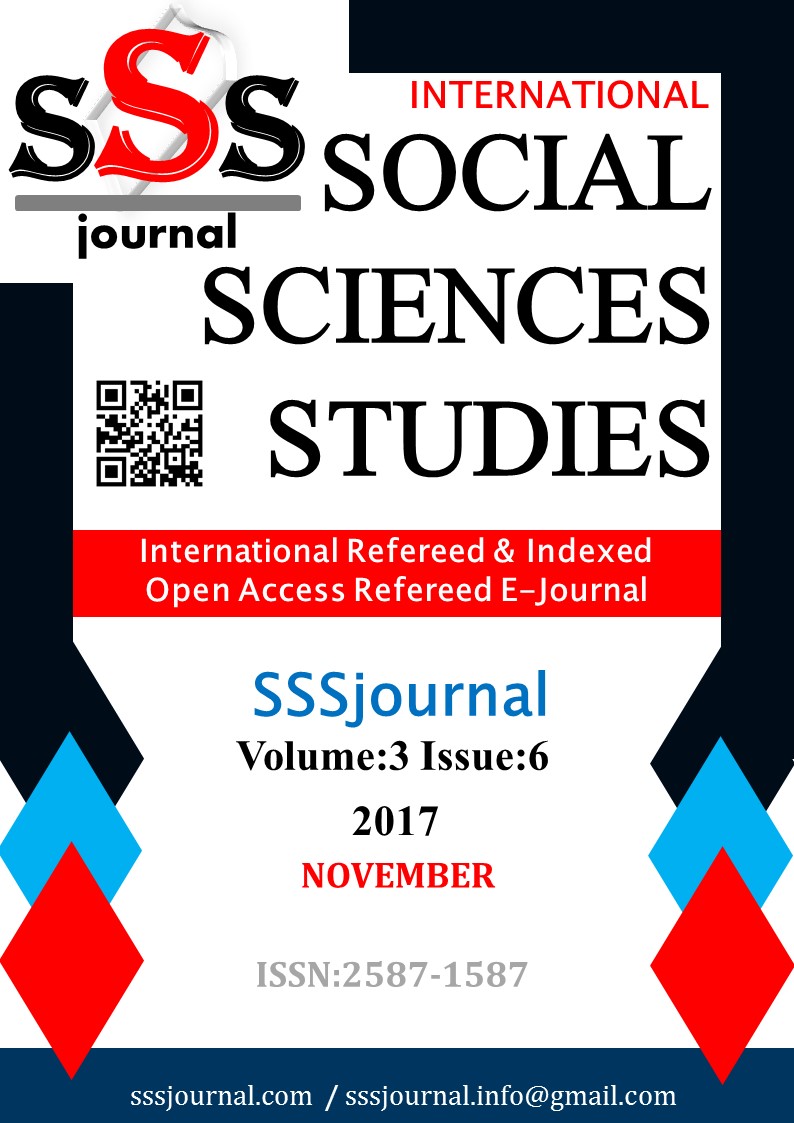Author :
Abstract
"The Good Anna" "Melanctha " ve "The Gentle Lena" adlı üç bölümden oluşan Three Lives işçi sınıfından üç kadının-- öyküsüdür. “Three Lives romanını yazarken Gertrude kendi sesini bulmak ve kendi zihinsel durumunu ortaya koymak istedi. Öykülerin akışı, hızı, gelişimi veya tutarlılığına çok az veya hiç dikkat etmedi” (Souhami, 1992: 9). Yirminci yüzyılın başlarında edebiyatın eski geleneklerinden etkilenen bazı çağdaşlarının aksine Stein eserlerinde dünyayı yeniden inşa etmeyi amaçlayan modernist bir öncüdür. Bir başka deyişle, o roman yazımında ondokuzuncu yüzyıl düzeni ve yapısından ayrılmayı başarır. Parçalanma tekniğini deneysel kullanarak, Stein okura ataerkil kuralların yıkıldığını ve etrafımızdaki bu parçalanmış dünyada nelerin ortaya çıkabileceğinden emin olamadığımızın mesajını vermektedir. Bu makale Stein’in Three Lives adlı romanındaki ataerkil kurallarının nasıl yıkıldığını göstermeyi amaçlamaktadır. Çalışma Stein’in üç kadın karakterin temsiliyle modernist dil bakış açısı ve feminist yaklaşımını vurgulamaktadır. Bu kadınlar, onları cinsiyet rolleri içinde tutsak eden ataerkil toplumda hayatta kalmak için çaba gösterirler. Onlardan biri toplumsal düzene meydan okurken, diğerleri aynı düzene teslim olup yaşamlarını kontrol edemezler.
Keywords
Abstract
Three Lives is a three-part novel of the narratives of three working-class women-- "The Good Anna" "Melanctha " and "The Gentle Lena." “In writing Three Lives, Gertrude wanted to find her own voice and to explore her own state of mind. She paid little or no attention to narrative flow, pace, development, or consistency” (Souhami, 1992: 9). Stein-- unlike some of her contemporaries influenced by old conventions of literature in the early twentieth century-- becomes a modernist pioneer who has an aim of reconstructing the world in her works. In other words, Stein manages to break away from the nineteenth century order and structure in fiction. Through experimenting the technique of fragmentation, Stein gives the reader the message that patriarchal laws were disrupted and we are not sure what may arise in this fragmented world around us. This paper aims at exploring how Stein demonstrates the breakdown of the patriarchal laws in Three Lives. It will focus on Stein’s modernist views towards language and her feminist approach through her portrayal of three female characters. These women have an effort to survive in the patriarchal society that traps them in gender roles. While one of them challenges the social order, the others yield the same order and cannot control their own lives.
Keywords
- Alexander, J. (2008). World Wisdom: Difference and Identity in Gertrude Stein's "Melanchta"A Thesis
- Alexander, J. (2008). World Wisdom: Difference and Identity in Gertrude Stein's "Melanchta"A ThesisGraduate College of Bowling Green State University. https://etd.ohiolink.edu/rws_etd/document/get/bgsu1213987268/inline (4.5.2017)
- Barlow, J. ed .(1994). Plays by American Women: 1930-1960. Applause, New York.
- Hobhouse, J. (1975). Everybody Who Was Anybody A Biblioghaphy of Gertrude Stein. G.P. Putnam’s sons, New York.
- Hoffman, M. (1976). Gertrude Stein. Twayne Publishers. Boston.
- Kalfopoulou, A. (1994). “Century Paradigms: Gertrude Stein's "Melanctha" and The Problem of FemaleEmpowerment” CBS Open Journals Aristotle University Thessaloniki ej.lib.cbs.dk/index.php/assc/article/download/1137/1140 (15.3.2017)
- Mc Michael, G. Ed. (1985). Concise Anthology of American Literature. Mac Millan Publishing Company. Ruddick, Lisa. (1990) Reading Gertrude Stein, Body, Text, Gnosis Ithaca: Cornel University Press.
- Stein, Gertrude. "Composition as Explanation." (1926). Gertrude Stein: Writings 1903-1932. Ed. Catharine R. Stimpson and Harriet Chessman. New York: The Library of America, 1998.
- ___________ "Portraits and Repetition." (1935). Gertrude Stein: Writings 1932-1946. By Stein. Ed. Catharine R. Stimpson and Harriet Chessman. New York: The Library of America, 1998. 195-336. Print.
- Stein, G. (1992). Three Lives. Diana Souhami (int.) Bantam Books. New York.
- Salas, Rodrigez. (2002). Eclectic Revolution: Illusory Femininty and Two-fold Mimicry in Gertrude Stein’sThree Lives Odisea: Revista de estudios ingleses, https://dialnet.unirioja.es/servlet/autor?codigo=310541 (3.4.2017)
- Wilder, T. (1947). "Introduction " to Gertrude Stein, Four in America New Haven: Yale Univ. Press, p. 6
- Wilson, Mary. (2006). Stein's The Gentle Lena, The Explicator, 64:2, 94- 96,http://dx.doi.org/10.3200/EXPL.64.2.94-96 (5.5.2017)





